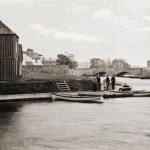Old Galway
OUR LADY’S BOYS CLUB, A BRIEF HISTORY (04 07 13)

When OLBC was founded in 1940, the Government provided no out of school education for young people. There was a great need for social and recreational facilities. Such activity was virtually non-existent in the working class areas of Bohermore, Shantalla, The Claddagh and ‘The West’. The critical core of the club was (and is) its generic youth club which met (and still meets) several evenings a week. The primary aim in those days was to show the boys ways and means of securing their own destiny.
AN HOUR TO REMEMBER (27 06 13)

It is hard to believe that president John F. Kennedy’s visit to Galway only lasted one hour. It was timed with military precision and yet JFK seemed remarkably relaxed and enjoying himself thoroughly throughout. He landed by helicopter in the Sportsground where he was met by the Mayor, Paddy Ryan, a group of schoolgirls from the Mercy National school all dressed in green white and gold, some members of the American legion, and a crowd of enthusiastic onlookers.An open Cadillac led a procession of cars with Garda outriders down College Road. JFK got out of his car to talk to Paddy Ryan’s mother who was sitting at her gate.
SALTHILL CHURCH, A BRIEF HISTORY (20 06 13)

A meeting of the residents of the Salthill area was held in the Pavilion Ballroom in June 1934 for the purposes of considering the necessity of erecting a church in Salthill. They unanimously expressed the urgency of building one to cater for the religious needs of about 300 families representing approximately 400 residents and a large number of summer visitors. At that time there were about 200 families from the Bishop’s Gate to Rockbarton and there was provision made for the building of close on 100 houses.
THE CLADDAGH NATIONAL SCHOOL (13 06 13)

An advertisement in the Irish Independent in July 1931 invited tenders from competent builders for the erection and completion of the proposed new St. Nicholas National School in the Claddagh. When the new school was built it was described as “An attractive rectangular building with a red tile roof made by the Galway Brick and Tile Company”. The outdoor toilets were at the end of the playground.
WHERE THERE’S A WILL, THERE’S A WAY (06 06 13)

Now that the Leaving Certificate Exams are about to start and the rowing season is in full swing, we thought to share the following story.
St. Joseph’s secondary school rowing club first competed in 1932 when they beat St. Patrick’s in the schoolboy fours. They soon became a force in rowing but in the early 1950’s, the club was at a low ebb. They had no clubhouse, no equipment and no coach.A few of the boys who were not involved in any other sport got together and decided to start a crew.
IN THEIR GREEN AND BLACK JERSEYS (30 05 13)

Victory in the 1961 County Juvenile Hurling Final for the Father Tom Burke’s Team from the Claddagh in the same colours their grandfathers wore in the great days of hurling in South Park recalled memories of the Moores, the Macs, the Currans and the Carricks.Many of these names were represented in the 1961 team who defeated Mullagh in the final by a score of 5 – 8 to 3 – 3. Mullagh started with the wind and the rain at their backs and led by 2 – 2 to 1 – 3 at half time. They scored another goal immediately after the restart and this shocked the Claddagh boys into action who quickly retaliated with goals by Gerry O’Grady and Lorcan O’Rourke. The writing was on the wall.
CALLING CASTLEGAR PEOPLE (23 05 13)

A report from the Educational Commission in Ireland in 1826 lists two hedge schools in the parish of Castlegar. The first of these was at Merlin Park, built by the landlord Mr. Blake. The forty boys and twenty girls who attended got free tuition. The second school was at Ballygurrane, a few hundred yards north of where Scoil Colmcille Naofa stands today. It was a thatched house which doubled as a church on Sundays. Each pupil paid one shilling and eight pence per quarter. There were thirty boys and fifteen girls on the rolls. The thatched house was accidentally burnt down in 1827, and the school transferred to a stable in the village of Castlegar.
THE ROYAL GALWAY YACHT CLUB (16 05 13)

The first rowing club to be set up on the river was Corrib Rowing and Yachting Club and shortly afterwards, the Commercial Club was founded. The inauguration of yet another club in 1882, The Royal Galway Yacht Club, provided further competition in rowing and yachting. It contributed to regattas locally by fielding crews, being included on committees and other rowing activities, and it seems to have had a very strong yachting section.It was situated on the corner of the Gaol River as you can see from our photograph which dates from c.1890 and was given to us by the National Library. The club was so titled in accordance with a Royal warrant granted in 1882 and a letter from the Secretary of State in 1885.
.png)